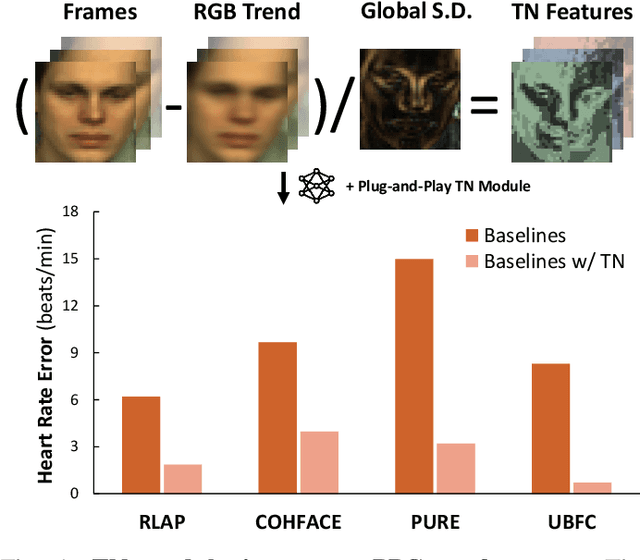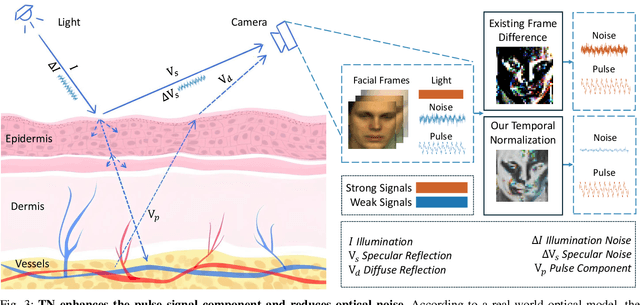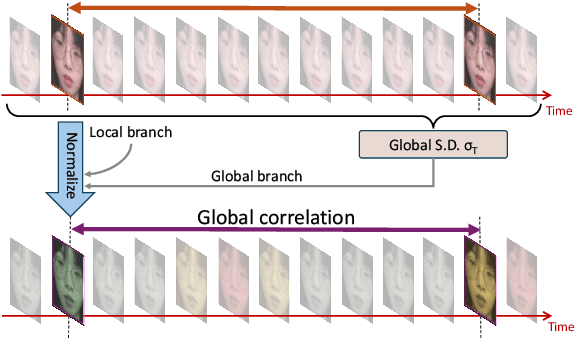Yuntao Wang
Resolving Ambiguity in Gaze-Facilitated Visual Assistant Interaction Paradigm
Sep 26, 2025Abstract:With the rise in popularity of smart glasses, users' attention has been integrated into Vision-Language Models (VLMs) to streamline multi-modal querying in daily scenarios. However, leveraging gaze data to model users' attention may introduce ambiguity challenges: (1) users' verbal questions become ambiguous by using pronouns or skipping context, (2) humans' gaze patterns can be noisy and exhibit complex spatiotemporal relationships with their spoken questions. Previous works only consider single image as visual modality input, failing to capture the dynamic nature of the user's attention. In this work, we introduce GLARIFY, a novel method to leverage spatiotemporal gaze information to enhance the model's effectiveness in real-world applications. Initially, we analyzed hundreds of querying samples with the gaze modality to demonstrate the noisy nature of users' gaze patterns. We then utilized GPT-4o to design an automatic data synthesis pipeline to generate the GLARIFY-Ambi dataset, which includes a dedicated chain-of-thought (CoT) process to handle noisy gaze patterns. Finally, we designed a heatmap module to incorporate gaze information into cutting-edge VLMs while preserving their pretrained knowledge. We evaluated GLARIFY using a hold-out test set. Experiments demonstrate that GLARIFY significantly outperforms baselines. By robustly aligning VLMs with human attention, GLARIFY paves the way for a usable and intuitive interaction paradigm with a visual assistant.
Enabling Regulatory Multi-Agent Collaboration: Architecture, Challenges, and Solutions
Sep 11, 2025



Abstract:Large language models (LLMs)-empowered autonomous agents are transforming both digital and physical environments by enabling adaptive, multi-agent collaboration. While these agents offer significant opportunities across domains such as finance, healthcare, and smart manufacturing, their unpredictable behaviors and heterogeneous capabilities pose substantial governance and accountability challenges. In this paper, we propose a blockchain-enabled layered architecture for regulatory agent collaboration, comprising an agent layer, a blockchain data layer, and a regulatory application layer. Within this framework, we design three key modules: (i) an agent behavior tracing and arbitration module for automated accountability, (ii) a dynamic reputation evaluation module for trust assessment in collaborative scenarios, and (iii) a malicious behavior forecasting module for early detection of adversarial activities. Our approach establishes a systematic foundation for trustworthy, resilient, and scalable regulatory mechanisms in large-scale agent ecosystems. Finally, we discuss the future research directions for blockchain-enabled regulatory frameworks in multi-agent systems.
Non-Contact Health Monitoring During Daily Personal Care Routines
Jun 11, 2025Abstract:Remote photoplethysmography (rPPG) enables non-contact, continuous monitoring of physiological signals and offers a practical alternative to traditional health sensing methods. Although rPPG is promising for daily health monitoring, its application in long-term personal care scenarios, such as mirror-facing routines in high-altitude environments, remains challenging due to ambient lighting variations, frequent occlusions from hand movements, and dynamic facial postures. To address these challenges, we present LADH (Long-term Altitude Daily Health), the first long-term rPPG dataset containing 240 synchronized RGB and infrared (IR) facial videos from 21 participants across five common personal care scenarios, along with ground-truth PPG, respiration, and blood oxygen signals. Our experiments demonstrate that combining RGB and IR video inputs improves the accuracy and robustness of non-contact physiological monitoring, achieving a mean absolute error (MAE) of 4.99 BPM in heart rate estimation. Furthermore, we find that multi-task learning enhances performance across multiple physiological indicators simultaneously. Dataset and code are open at https://github.com/McJackTang/FusionVitals.
Internet of Agents: Fundamentals, Applications, and Challenges
May 12, 2025



Abstract:With the rapid proliferation of large language models and vision-language models, AI agents have evolved from isolated, task-specific systems into autonomous, interactive entities capable of perceiving, reasoning, and acting without human intervention. As these agents proliferate across virtual and physical environments, from virtual assistants to embodied robots, the need for a unified, agent-centric infrastructure becomes paramount. In this survey, we introduce the Internet of Agents (IoA) as a foundational framework that enables seamless interconnection, dynamic discovery, and collaborative orchestration among heterogeneous agents at scale. We begin by presenting a general IoA architecture, highlighting its hierarchical organization, distinguishing features relative to the traditional Internet, and emerging applications. Next, we analyze the key operational enablers of IoA, including capability notification and discovery, adaptive communication protocols, dynamic task matching, consensus and conflict-resolution mechanisms, and incentive models. Finally, we identify open research directions toward building resilient and trustworthy IoA ecosystems.
Security of Internet of Agents: Attacks and Countermeasures
May 12, 2025Abstract:With the rise of large language and vision-language models, AI agents have evolved into autonomous, interactive systems capable of perception, reasoning, and decision-making. As they proliferate across virtual and physical domains, the Internet of Agents (IoA) has emerged as a key infrastructure for enabling scalable and secure coordination among heterogeneous agents. This survey offers a comprehensive examination of the security and privacy landscape in IoA systems. We begin by outlining the IoA architecture and its distinct vulnerabilities compared to traditional networks, focusing on four critical aspects: identity authentication threats, cross-agent trust issues, embodied security, and privacy risks. We then review existing and emerging defense mechanisms and highlight persistent challenges. Finally, we identify open research directions to advance the development of resilient and privacy-preserving IoA ecosystems.
A Dataset and Toolkit for Multiparameter Cardiovascular Physiology Sensing on Rings
May 08, 2025



Abstract:Smart rings offer a convenient way to continuously and unobtrusively monitor cardiovascular physiological signals. However, a gap remains between the ring hardware and reliable methods for estimating cardiovascular parameters, partly due to the lack of publicly available datasets and standardized analysis tools. In this work, we present $\tau$-Ring, the first open-source ring-based dataset designed for cardiovascular physiological sensing. The dataset comprises photoplethysmography signals (infrared and red channels) and 3-axis accelerometer data collected from two rings (reflective and transmissive optical paths), with 28.21 hours of raw data from 34 subjects across seven activities. $\tau$-Ring encompasses both stationary and motion scenarios, as well as stimulus-evoked abnormal physiological states, annotated with four ground-truth labels: heart rate, respiratory rate, oxygen saturation, and blood pressure. Using our proposed RingTool toolkit, we evaluated three widely-used physics-based methods and four cutting-edge deep learning approaches. Our results show superior performance compared to commercial rings, achieving best MAE values of 5.18 BPM for heart rate, 2.98 BPM for respiratory rate, 3.22\% for oxygen saturation, and 13.33/7.56 mmHg for systolic/diastolic blood pressure estimation. The open-sourced dataset and toolkit aim to foster further research and community-driven advances in ring-based cardiovascular health sensing.
Memory-efficient Low-latency Remote Photoplethysmography through Temporal-Spatial State Space Duality
Apr 02, 2025Abstract:Remote photoplethysmography (rPPG), enabling non-contact physiological monitoring through facial light reflection analysis, faces critical computational bottlenecks as deep learning introduces performance gains at the cost of prohibitive resource demands. This paper proposes ME-rPPG, a memory-efficient algorithm built on temporal-spatial state space duality, which resolves the trilemma of model scalability, cross-dataset generalization, and real-time constraints. Leveraging a transferable state space, ME-rPPG efficiently captures subtle periodic variations across facial frames while maintaining minimal computational overhead, enabling training on extended video sequences and supporting low-latency inference. Achieving cross-dataset MAEs of 5.38 (MMPD), 0.70 (VitalVideo), and 0.25 (PURE), ME-rPPG outperforms all baselines with improvements ranging from 21.3% to 60.2%. Our solution enables real-time inference with only 3.6 MB memory usage and 9.46 ms latency -- surpassing existing methods by 19.5%-49.7% accuracy and 43.2% user satisfaction gains in real-world deployments. The code and demos are released for reproducibility on https://github.com/Health-HCI-Group/ME-rPPG-demo.
Exploring Reliable PPG Authentication on Smartwatches in Daily Scenarios
Mar 31, 2025Abstract:Photoplethysmography (PPG) Sensors, widely deployed in smartwatches, offer a simple and non-invasive authentication approach for daily use. However, PPG authentication faces reliability issues due to motion artifacts from physical activity and physiological variability over time. To address these challenges, we propose MTL-RAPID, an efficient and reliable PPG authentication model, that employs a multitask joint training strategy, simultaneously assessing signal quality and verifying user identity. The joint optimization of these two tasks in MTL-RAPID results in a structure that outperforms models trained on individual tasks separately, achieving stronger performance with fewer parameters. In our comprehensive user studies regarding motion artifacts (N = 30), time variations (N = 32), and user preferences (N = 16), MTL-RAPID achieves a best AUC of 99.2\% and an EER of 3.5\%, outperforming existing baselines. We opensource our PPG authentication dataset along with the MTL-RAPID model to facilitate future research on GitHub.
WatchGuardian: Enabling User-Defined Personalized Just-in-Time Intervention on Smartwatch
Feb 09, 2025Abstract:While just-in-time interventions (JITIs) have effectively targeted common health behaviors, individuals often have unique needs to intervene in personal undesirable actions that can negatively affect physical, mental, and social well-being. We present WatchGuardian, a smartwatch-based JITI system that empowers users to define custom interventions for these personal actions with a small number of samples. For the model to detect new actions based on limited new data samples, we developed a few-shot learning pipeline that finetuned a pre-trained inertial measurement unit (IMU) model on public hand-gesture datasets. We then designed a data augmentation and synthesis process to train additional classification layers for customization. Our offline evaluation with 26 participants showed that with three, five, and ten examples, our approach achieved an average accuracy of 76.8%, 84.7%, and 87.7%, and an F1 score of 74.8%, 84.2%, and 87.2% We then conducted a four-hour intervention study to compare WatchGuardian against a rule-based intervention. Our results demonstrated that our system led to a significant reduction by 64.0 +- 22.6% in undesirable actions, substantially outperforming the baseline by 29.0%. Our findings underscore the effectiveness of a customizable, AI-driven JITI system for individuals in need of behavioral intervention in personal undesirable actions. We envision that our work can inspire broader applications of user-defined personalized intervention with advanced AI solutions.
A Plug-and-Play Temporal Normalization Module for Robust Remote Photoplethysmography
Nov 22, 2024



Abstract:Remote photoplethysmography (rPPG) extracts PPG signals from subtle color changes in facial videos, showing strong potential for health applications. However, most rPPG methods rely on intensity differences between consecutive frames, missing long-term signal variations affected by motion or lighting artifacts, which reduces accuracy. This paper introduces Temporal Normalization (TN), a flexible plug-and-play module compatible with any end-to-end rPPG network architecture. By capturing long-term temporally normalized features following detrending, TN effectively mitigates motion and lighting artifacts, significantly boosting the rPPG prediction performance. When integrated into four state-of-the-art rPPG methods, TN delivered performance improvements ranging from 34.3% to 94.2% in heart rate measurement tasks across four widely-used datasets. Notably, TN showed even greater performance gains in smaller models. We further discuss and provide insights into the mechanisms behind TN's effectiveness.
 Add to Chrome
Add to Chrome Add to Firefox
Add to Firefox Add to Edge
Add to Edge